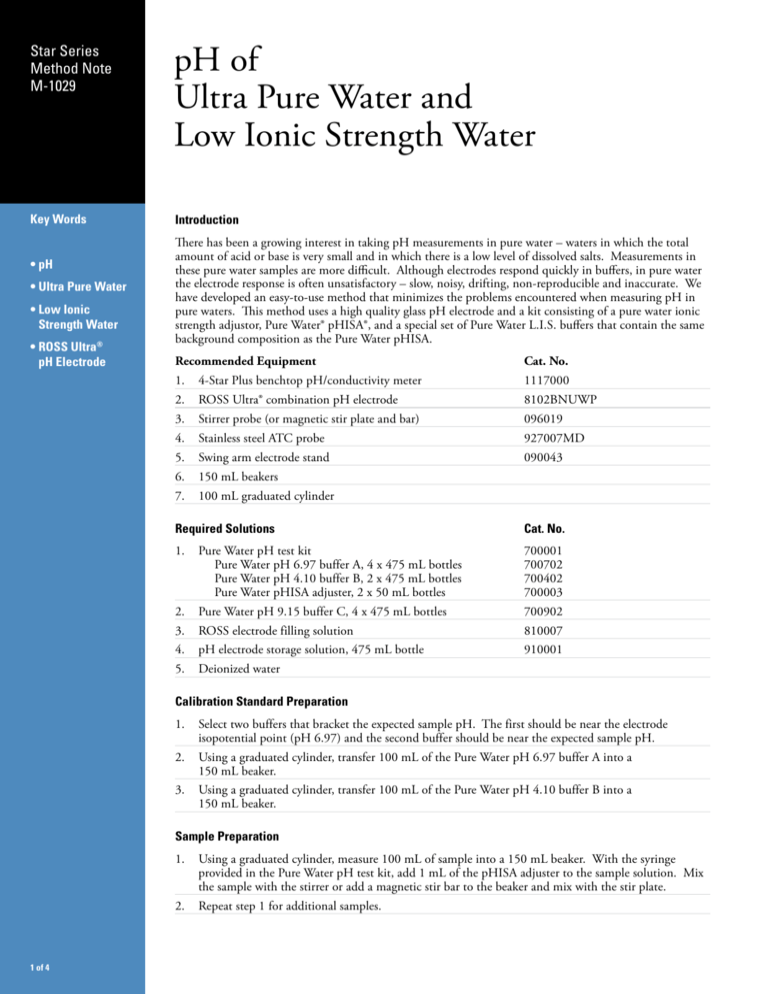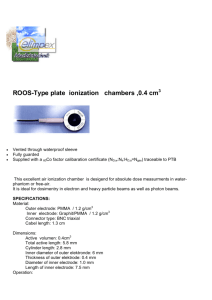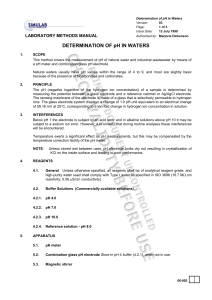
Star Series
Method Note
M-1029
pH of Ultra Pure Water and Low Ionic Strength Water
Key Words
Introduction
• pH
• Ultra Pure Water
• Low Ionic
Strength Water
• ROSS Ultra®
pH Electrode
There has been a growing interest in taking pH measurements in pure water – waters in which the total
amount of acid or base is very small and in which there is a low level of dissolved salts. Measurements in
these pure water samples are more difficult. Although electrodes respond quickly in buffers, in pure water
the electrode response is often unsatisfactory – slow, noisy, drifting, non-reproducible and inaccurate. We
have developed an easy-to-use method that minimizes the problems encountered when measuring pH in
pure waters. This method uses a high quality glass pH electrode and a kit consisting of a pure water ionic
strength adjustor, Pure Water® pHISA®, and a special set of Pure Water L.I.S. buffers that contain the same
background composition as the Pure Water pHISA.
Recommended Equipment
Cat. No.
1. 4-Star Plus benchtop pH/conductivity meter
1117000
2. ROSS Ultra® combination pH electrode
8102BNUWP
3. Stirrer probe (or magnetic stir plate and bar)
096019
4. Stainless steel ATC probe
927007MD
5. Swing arm electrode stand 090043 6. 150 mL beakers
7. 100 mL graduated cylinder
Required Solutions
Cat. No.
1. Pure Water pH test kit Pure Water pH 6.97 buffer A, 4 x 475 mL bottles Pure Water pH 4.10 buffer B, 2 x 475 mL bottles
Pure Water pHISA adjuster, 2 x 50 mL bottles
700001
700702
700402
700003
2. Pure Water pH 9.15 buffer C, 4 x 475 mL bottles
700902
3. ROSS electrode filling solution
810007
4. pH electrode storage solution, 475 mL bottle
910001
5. Deionized water
Calibration Standard Preparation
1. Select two buffers that bracket the expected sample pH. The first should be near the electrode
isopotential point (pH 6.97) and the second buffer should be near the expected sample pH.
2. Using a graduated cylinder, transfer 100 mL of the Pure Water pH 6.97 buffer A into a 150 mL beaker. 3. Using a graduated cylinder, transfer 100 mL of the Pure Water pH 4.10 buffer B into a 150 mL beaker.
Sample Preparation
1. Using a graduated cylinder, measure 100 mL of sample into a 150 mL beaker. With the syringe
provided in the Pure Water pH test kit, add 1 mL of the pHISA adjuster to the sample solution. Mix
the sample with the stirrer or add a magnetic stir bar to the beaker and mix with the stir plate.
2. Repeat step 1 for additional samples.
1 of 4
pH of Ultra Pure Water and Low Ionic Strength Water
Results
Five aliquots of pure water are measured and the results provide representative results expected for pH in pure water. Pure Water
pH
Sample # 1:
5.81
Sample # 2:
5.81
Sample # 3:
5.80
Sample # 4:
5.75
Sample # 5:
5.74
Mean:
5.78
Standard Deviation:
0.03
%CV:
0.59
Electrode Storage
To ensure a quick response and free-flowing liquid junction, the pH electrode sensing element and reference
junction must remain wet and should not be allowed to dry out.
For short-term storage periods between sample measurements and up to one week, soak the electrode in pH
electrode storage solution. If storage solution is not available, use about 200 mL of pH 7 buffer to which about
1 gram of KCl has been added as a temporary substitute.
For longer storage periods, the reference chamber should be filled and the filling hole covered. Cover the
sensing element and reference junction with the protective cap containing a few drops of storage solution. The ATC probe has no special storage requirements.
Equipment Setup
Electrode Setup – ROSS Ultra pH Electrode
1. Remove the protective shipping cap from the electrode sensing element and save the cap for storage.
2. Clean any salt deposits from the electrode exterior by rinsing it with deionized water.
3. Uncover the filling hole by removing the tape or plastic sleeve. Add ROSS filling solution to electrode up
to the fill hole. To maintain an adequate flow rate, the level of filling solution must cover the coil and be at
least one inch above the sample level when the electrode is immersed in sample.
4. Place the electrode in the electrode holder and suspend it in air for 15 minutes to thoroughly wet the
reference junction. Once junction is wet, do not allow the electrode to dry out.
5. Shake the electrode downwards to remove air bubbles.
6. Soak the electrode in pH electrode storage solution for one hour.
Electrode Setup – ATC Probe
1. Clean any deposits from the probe exterior by rinsing it with deionized water.
2 of 4
Meter Setup – 4-Star Plus Benchtop pH/Conductivity Meter
For initial meter setup, follow the steps in the quick start guide that is included with the meter. The quick start
guide also contains a layout of the meter keypad for reference. The words in all capital letters, such as POWER,
indicate a key on the meter and words in quotations, such as “rES”, indicate a display on the meter screen.
1. Connect the electrode to the meter. 2. Connect the stirrer to the meter.
3. Connect the ATC probe to the meter.
4. Press the POWER key on the meter to turn the meter on.
5. Note that the arrow icon on the left of the screen indicates the active line. If the top line is not active, press
the LINE SELECT key to change the selected line to the top line. Press the UP or DOWN ARROW key
to change the measurement mode of the top line to pH.
6. Press the SETUP key. Press the UP or DOWN ARROW key until “PH” is displayed on the top line.
7. Press the LINE SELECT key to select the middle line. Press the UP or DOWN ARROW key to select
“rES”, which is for pH resolution and the number of significant digits that will be displayed on the meter. Press the LINE SELECT key to select the bottom line. Press the UP or DOWN ARROW key to select
“0.01” for “rES”. Press the LINE SELECT key to accept the setting.
8. Press the LINE SELECT key to select the middle line. Press the UP or DOWN ARROW key to select
“bUF”, which is for the pH buffer set that will be used for automatic buffer recognition. Press the LINE
SELECT key to select the bottom line. Press the UP or DOWN ARROW key to select “USA”, which is
for Thermo Scientific Orion 1.68, 4.01, 7.00, 10.01 and 12.46 buffers. Press the LINE SELECT key to
accept the setting.
9. Press the MEASURE key to return to the measurement mode.
10. If all steps were followed correctly, the meter display will show two digits after the decimal place in the top
line and “pH” to the right of the top line. The meter and electrode are now ready for calibration.
3 of 4
Calibration and Analysis
1. Allow all the standards and the samples to reach room temperature for precise measurements, since pH measurements are temperature sensitive. For the most accurate calibration, use a water bath to adjust the temperature of the buffers to
25.0 °C ± 1.0 °C.
2. Prepare the Pure Water pH 6.97 buffer A and Pure Water pH 4.10 buffer B as described in the Calibration Standard
Preparation section. 3. Place the electrode, ATC probe and stirrer into the beaker with the Pure Water pH 6.97 buffer A, so the electrode tip is
fully immersed in the solution. The stirrer should be positioned slightly below the tip of the electrode. Press the STIR
key on the meter to turn the stirrer on.
4. Press the CALIBRATE key.
5. Wait for a stable reading, usually in 1 to 2 minutes. When a stable reading is displayed, use the DIGIT key and UP and
DOWN ARROW keys to enter the pH value of the Pure Water buffer A at the measured temperature (a table of pH
values at various temperatures is provided on the buffer bottle). Press the DIGIT key until the first digit to be changed
is flashing, press the UP and DOWN ARROW keys to change the value of the flashing digit and continue to change the
digits until the meter displays the correct pH value of the buffer. Once the value is set, press the DIGIT key until the
decimal point is in the correct location.
6. Press the CALIBRATE key to accept the Pure Water buffer A pH value and press the STIR key to turn the stirrer off.
7. Rinse the electrode, ATC probe and stirrer thoroughly with deionized water and then with the Pure Water pH 4.10
buffer B. Remove excess solution from the electrode, ATC probe and stirrer by gently blotting with a lint-free tissue. Do
not wipe or rub the sensing bulb on the pH electrode.
8. Place the electrode, ATC probe and stirrer into beaker with the Pure Water pH 4.10 buffer B, so the electrode tip is fully
immersed in the solution. The stirrer should be positioned slightly below the tip of the electrode. Press the STIR key on
the meter to turn the stirrer on.
9. Wait for a stable reading, usually in 1 to 2 minutes. When a stable reading is displayed, use the DIGIT key and UP and
DOWN ARROW keys to enter the pH value of the Pure Water buffer B at the measured temperature (a table of pH
values at various temperatures is provided on the buffer bottle). Press the DIGIT key until the first digit to be changed
is flashing, press the UP and DOWN ARROW keys to change the value of the flashing digit and continue to change the
digits until the meter displays the correct pH value of the buffer. Once the value is set, press the DIGIT key until the
decimal point is in the correct location.
10. Press the MEASURE key to accept the Pure Water buffer B pH value and return to the measurement mode. Press the
STIR key to turn the stirrer off.
11. Rinse the electrode, ATC probe and stirrer thoroughly with deionized water. Remove excess solution from the electrode, ATC probe and stirrer by gently blotting with a lint-free tissue. Do not wipe or rub the sensing bulb on the
pH electrode.
12. Prepare a sample as described in the Sample Preparation section.
13. Place the electrode in a prepared sample with the electrode tip fully immersed in the solution. Press the MEASURE key
on the meter and the stirrer will turn on. The pH icon will flash as the measurement is being made. The pH icon will
become solid and the display value will freeze when a stable reading is achieved. The stirrer turns off automatically.
14. Repeat steps 11 through 13 for additional samples. When all samples have been measured, rinse the electrode, ATC
probe and stirrer with deionized water and store the electrode according to the Electrode Storage section.
©2008 Thermo Fisher Scientific Inc. All rights reserved. All trademarks are the property of Thermo Fisher Scientific Inc.
and its subsidiaries. ROSS and the COIL trade dress are trademarks of Thermo Fisher Scientific Inc.
Environmental Instruments
Water Analysis Instruments
North America
166 Cummings Center
Beverly, MA 01915 USA
Toll Free: 1-800-225-1480
Tel: 1-978-232-6000
Dom. Fax: 1-978-232-6015
Int’l Fax: 978-232-6031
Europe
Denmark House, Angel Drove
Ely, Cambridgeshire
England, CB7 4ET
Tel: 44-1353-666111
Fax: 44-1353-666001
Asia Pacific
Blk 55, Ayer Rajah Crescent
#04-16/24, Singapore 139949
Tel: 65-6778-6876
Fax: 65-6773-0836
www.thermo.com/water
257456-001 Rev. A 07-08






